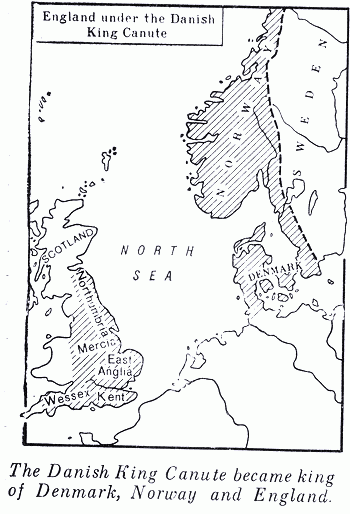New Attacks of the Danes
Category: 11th centuryAt the end of the 10th century the Danish invasions were resumed. The Anglo-Saxon kings were unable to organize any effective resistance and they tried to buy off the Danes. The Anglo-Saxon kings gave them money to leave them in peace. The result was that they came again in greater numbers the following year to demand more. In order to make this payment to the Danes in 991 the government imposed a heavy tax called Danegeld, or Dane money. And every time the Danes came back they received more and the government, in its turn, increased the tax of Danegeld collected from the population.
 At the beginning of the 11th century England was conquered by the Danes once more. The Danish King Canute (1017-1035) became king of Denmark, Norway and England. He made England the centre of his power. But he was often away from England in his kingdom of Denmark and so he divided the country into four parts called earldoms. They were Wessex, Mercia, Northumbria and East Anglia. An earl was appointed by the king to rule over each great earldom. The earls ruled over great territories and gradually they became very powerful.
At the beginning of the 11th century England was conquered by the Danes once more. The Danish King Canute (1017-1035) became king of Denmark, Norway and England. He made England the centre of his power. But he was often away from England in his kingdom of Denmark and so he divided the country into four parts called earldoms. They were Wessex, Mercia, Northumbria and East Anglia. An earl was appointed by the king to rule over each great earldom. The earls ruled over great territories and gradually they became very powerful.
To secure his position in the conquered country Canute continued to collect the Danegeld tax, and used the money to support a bodyguard of professional fighting men and a large fleet. So the Dane money which had been originally collected for the struggle against the Danes became now a tax paid for the benefit of the Danish king. The king’s well-disciplined bodyguard of several thousand horsemen was, in fact, a standing army; it was always ready to suppress a rebellion in any part of the country. Besides, Canute tried to win the support of the big Anglo-Saxon feudal lords. He promised to rule according to the old Anglo-Saxon laws. As before the Anglo-Saxon lords had the right to administer justice in the neighbourhood. The other old laws which gave them great power over the common people were also preserved. Canute sent back most of his Danish followers to their own country.
He usually chose Anglo-Saxon nobles for the high posts of earls and other royal officials, Canute himself became a Christian and he sent monks from Canterbury to convert his subjects in Scandinavia to Christianity too. He was the protector of the monasteries and learning that developed there. The clergy grew more powerful in his reign. Supported by the Anglo-Saxon feudal lords Canute ruled in England till he died. After the death of Canute his kingdom split up and soon afterwards an Anglo-Saxon king came to the throne (1042) and the line of Danish kings came to an end.
